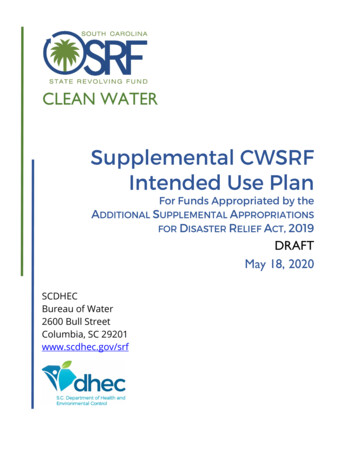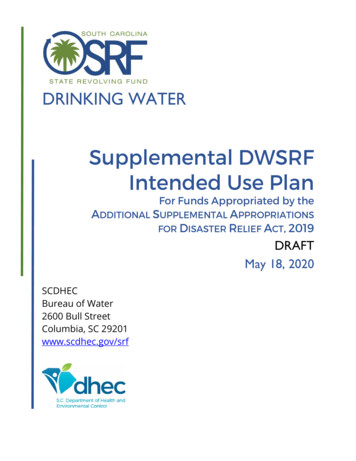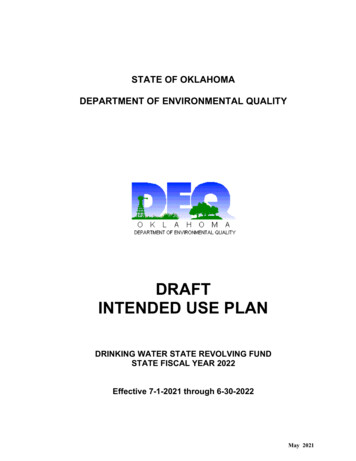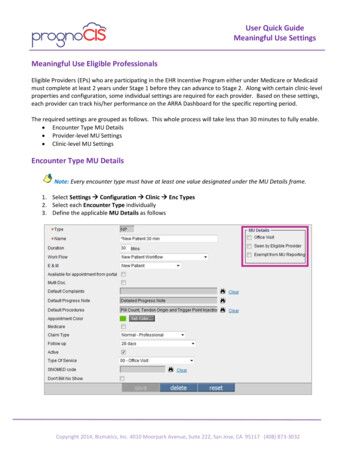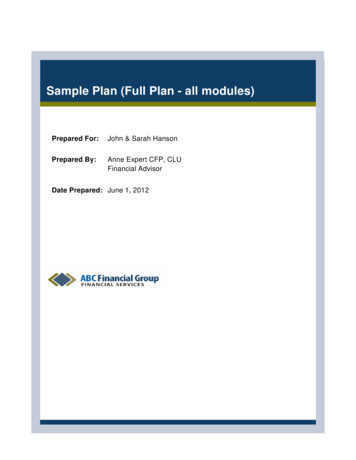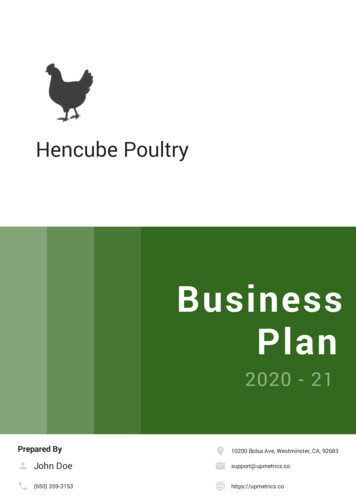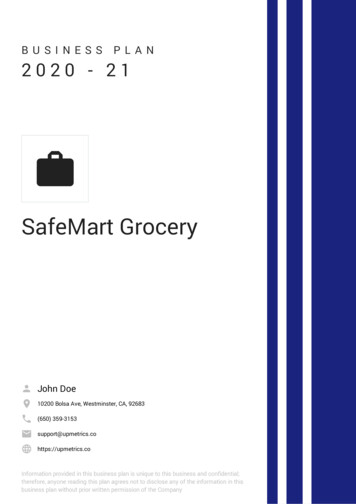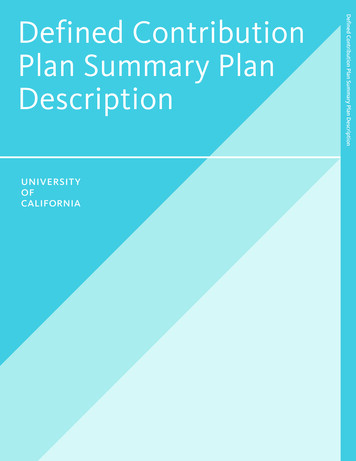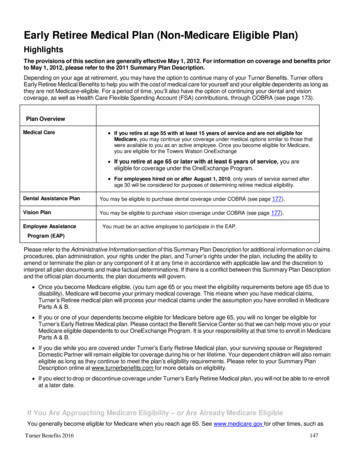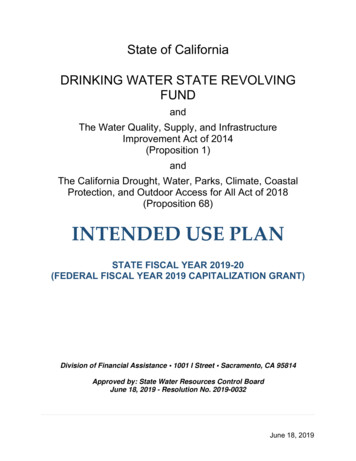
Transcription
State of CaliforniaDRINKING WATER STATE REVOLVINGFUNDandThe Water Quality, Supply, and InfrastructureImprovement Act of 2014(Proposition 1)andThe California Drought, Water, Parks, Climate, CoastalProtection, and Outdoor Access for All Act of 2018(Proposition 68)INTENDED USE PLANSTATE FISCAL YEAR 2019-20(FEDERAL FISCAL YEAR 2019 CAPITALIZATION GRANT)Division of Financial Assistance 1001 I Street Sacramento, CA 95814Approved by: State Water Resources Control BoardJune 18, 2019 - Resolution No. 2019-0032June 18, 2019
TABLE OF CONTENTSI.INTRODUCTION . 4A. SFY 2019-20 Highlights . 4B. Authority and Past Achievements . 5C. Connections to Other Plans and Goals . 6D. Intended Use Plan (IUP) and Capitalization Grant Application. 9E. Supplementary Definitions . 10II.DRINKING WATER FINANCING NEEDS . 12A. Drinking Water Needs Survey and Assessment . 12B. Comprehensive List of Financing Requests . 12III.PROJECT FUNDING CAPACITY AND DISTRIBUTION OF FUNDS. 13A. General Project Funding Approach . 13B. Recent Financing Activity . 21C. Financial Outlook . 22D. Development of the Fundable List . 25E. Financing Forecast . 27F. Future Financing Trends . 28G. DWSRF Resources and Workload . 28H. Risks. 31IV.SET-ASIDE ACTIVITIES . 35A. Administration Set-Aside . 35B. Small Water system Technical Assistance Set-Aside . 36C. State Program Management Set-Aside . 36D. Local Assistance Set-Aside . 37V.FINANCING AND PROGRAMMATIC REQUIREMENTS . 39A. Technical Managerial and Financial (TMF) Capacity . 39B. Cap Grant Payments and draws . 40C. 2019 State Match Source and Proportionality Draw . 41D. Application of Federal Cross-Cutters. 42E. Capitalization Grant Conditions and Other Federal Requirements . 44F. Other State and State Water Board Requirements. 442 PageJune 18, 2019
G. Other Assurances and Certifications . 46H. Cross-Collateralization . 47VI.OUTCOMES, GOALS, ACTIVITIES, AND MEASURES . 48A. Prioritizing DWSRF Funds For Public Health Benefits . 48B. Manage the DWSRF ResponsiblY to Ensure its Perpetuity. 49C. Ensuring Timely and Expeditious Use of DWSRF Funds . 50D. DWSRF Performance Metrics . 51VII.SCHEDULE . 52VIII. ACRONYMS . 53IX.APPENDICES . 54APPENDIX A: SFY 2019-20 DWSRF FUNDABLE LIST . 54APPENDIX B: SFY 2019-20 DWSRF COMPREHENSIVE LIST . 101APPENDIX C: SFY 2019-20 DWSRF IUP Fiscal Impact Summary. 139APPENDIX D: Planning Project-Reduced Interest Rates and Grant for an EligiblePWS . 140APPENDIX E: Construction Project Financing Limitations for an Eligible SCWS thatServes a SMALL DAC or SMALL SDAC or a PWS Extending Water Service to aSMALL DAC or SMALL SDAC Not Currently Served by a PWS. 141APPENDIX F: Construction Project Financing Limitations for an ESCWS that Servesa DAC or an SDAC . 142APPENDIX G: Construction Project Financing Limitations for an Eligible NTNC thatServes a Small DAC or a Small SDAC . 142APPENDIX H: FFY 2019 Estimated Federal Capitalization Grant Cash DrawSchedule . 1443 PageJune 18, 2019
I. INTRODUCTIONClean and safe drinking water is a fundamental human right1, and is essential to healthand well-being. The State Water Resources Control Board (State Water Board) and itsDivision of Drinking Water (DDW) and Division of Financial Assistance (DFA) workcooperatively to protect California’s drinking water and help ensure that all Californianshave access to clean, safe, and affordable drinking water through several regulatoryand financial assistance programs.The Drinking Water State Revolving Fund (DWSRF) program finances infrastructureimprovements to mitigate drinking water risks and support the human right to water. Inaccordance with federal rules, the DWSRF program generally prioritizes financing forprojects that (1) address the most serious human health risks, (2) are necessary tocomply with Safe Drinking Water Act (SDWA) ubchapXII.pdf), and (3) assist public water systems (PWSs) most in need on aper household basis. The DWSRF program is also managed to ensure expeditious useof DWSRF funds and long-term financial strength for future generations.The State of California (State) also periodically allocates funding to the State WaterBoard for financing programs that help provide clean and safe water. Many of theseprograms can be used in combination with the DWSRF program.This Intended Use Plan (IUP) describes the State Water Board’s plan for implementingthe DWSRF and its complementary financing programs for drinking water projects to befunded in State Fiscal Year (SFY) 2019-20.A. SFY 2019-20 HIGHLIGHTSThe SFY 2019-20 IUP reflects several changes that were included in the amendedDWSRF Policy(https://www.waterboards.ca.gov/drinking wsrf policy final.pdf) approved by the State Water Board on February 5, 2019to better manage the program. These are highlighted briefly below: 1Small Severely Disadvantaged Communities (Small SDAC) and smallDisadvantaged Communities (Small DAC) will be automatically added to theFundable List at any time these communities start an application.A non-SDAC or non-DAC project that is ready to proceed to an agreement will beadded to the Fundable List bypassing other projects that are not ready to proceed toan agreement.Water Code, Section 106.34 PageJune 18, 2019
All applicants may request repayable financing up to 30 years or the useful life of thefinanced assets for construction financing, and a system that serves a DAC or SDACis eligible for a repayment term of up to 40 years or the useful life of the financedassets for construction financing.Applicants may finance planning over a 5- or 10-year term at their option.Repayments on future loans will be annual, not semi-annual.The first principal and interest payment will be due 18 months after projectcompletion for Small DAC/Small SDAC, and 12 months for non-DAC/non-SDACrecipients.Reimbursing construction costs incurred prior to approval of financing under limitedconditions.Use of the newly developed “Credit/Financial Guidelines,” Appendix E(https://www.waterboards.ca.gov/drinking water/services/funding/documents/srf/dwsrf policy 2018/dwsrf 2018 appx e credit fin guidelines.pdf), to the DWSRFPolicy.California’s DWSRF program continues to evolve since its transfer from the CaliforniaDepartment of Public Health. In addition, the level of DWSRF and complementaryfinancing has been below average in SFY 2018-19 due to the State Water Boards’transition to California’s new, statewide accounting and budgeting system, the FinancialInformation System for California or “FI Cal.” DFA expects that the slower pace offinancing will continue into SFY 2019-20, but that the overall pace of financing will returnto a level similar to previous levels after FI Cal is fully implemented by the State WaterBoard.B. AUTHORITY AND PAST ACHIEVEMENTSIn 1996, the United States Congress and the President amended the SDWA to establishthe DWSRF program nationally, based in part on the success of the Clean Water StateRevolving Fund (CWSRF) program. All 50 states and Puerto Rico are currentlyoperating DWSRF programs. The total DWSRF program financing nationwide currentlyexceeds 39.0 billion.The federal DWSRF program provides each state the opportunity to establish a drinkingwater public health and infrastructure bank capitalized by federal and state funds. Thiscapital along with its earnings is used to provide financial assistance to a wide variety ofdrinking water planning and construction projects. The DWSRF program can alsoprovide technical assistance (TA) to help PWSs solve their drinking water problems.States may offer a variety of financing options and customize terms to meet theirdrinking water public health needs. Financing options include loans, refinancing debt,purchasing or guaranteeing local debt, and purchasing bond insurance. Interest ratesmust be below the market rate. Repayment periods are generally the lesser of 30 yearsor the expected useful life of the financed asset and can be as long as 40 years forsome communities. Federal statute, regulations and appropriations, as well as5 PageJune 18, 2019
California law, have also authorized “additional subsidy” in the form of grants, negativeinterest rates, and principal forgiveness (PF) on a limited basis. The State Water Boardis currently authorized to manage the DWSRF program pursuant to Chapter 4.5 of Part12 of Division 104 of the Health and Safety Code and an Operating Agreement(https://www.waterboards.ca.gov/drinking ppendix b.pdf) with the United States Environmental Protection Agency (U.S.EPA), Region 9. The DFA, in cooperation with DDW, the Division of AdministrativeServices (DAS), and the Office of Chief Counsel (OCC), implements the DWSRFprogram in accordance with the Policy for Implementing the Drinking Water StateRevolving Fund(https://www.waterboards.ca.gov/drinking water/services/funding/DWSRF Policy.shtml)(DWSRF Policy) as approved by the State Water Board.California’s DWSRF has grown since financing its first project in 2000. It has executedmore than 3.03 billion in financial assistance agreements. The net position of theDWSRF is approximately 1.8 billion, and annual repayments to the DWSRF haverecently been approximately 84.4 million.The DWSRF program has funded a broad range of projects since its inception. As ofJune 30, 2018, approximately percent (85%) of DWSRF funds have been for the benefitof large water systems, while approximately 15 percent (15%) of DWSRF funds havebeen awarded to small water systems (SWSs). However, approximately 68 percent(68%) of funded projects have been for the benefit of SWSs, while 32 percent (32%) offunded projects have been for the benefit of large water systems. The DWSRF has alsoprovided approximately 385 million of principal forgiveness/grants to disadvantagedcommunities since 2000.C. CONNECTIONS TO OTHER PLANS AND GOALSIn establishing the terms of this IUP, the State Water Board considered statewide policyset forth in section 106.3 of the Water Code. Specifically, subdivision (a) declares it isthe established policy of the State that “every human being has the right to safe, clean,affordable, and accessible water adequate for human consumption, cooking, andsanitary purposes.” Subdivision (b) requires the State Water Board to consider thisstate policy when “revising, adopting, or establishing policies, regulations, and grantcriteria when those policies, regulations, and criteria are pertinent to the uses of water.”State Water Board Resolution 2016-0010 adopted the human right to water as a corevalue and directed its implementation in Water Board programs and activities. This IUPdirectly supports this policy.U.S. EPA, in cooperation with the State, has designated the State Water Board asthe “primacy agency” to implement and enforce the federal SDWA. As the stateprimacy agency, the State Water Board, through DDW, regulates more than 7,5006 PageJune 18, 2019
PWSs located throughout the State. To assist in this effort, through DDW, theState Water Board has also delegated its primacy authority to 30 local healthdepartments, known as local primacy agencies (LPA), to regulate PWSs servingless than 200 service connections. The State Water Board also promotes safeand reliable drinking water through drought preparedness and water conservationmeasures; promoting water recycling projects; certifying drinking water treatmentand distribution operators; supporting and promoting water system security;providing for small water system technical assistance (SWSTA) and mandatingminimum standards for PWS technical, managerial, and financial (TMF) capacity.The DWSRF program supports the U.S. EPA Strategic ) Goal 1 (Core Mission), Objective 1.2: Provide for Clean and SafeWater – “Ensure waters are clean through improved water infrastructure and, inpartnership with states and tribes, sustainably manage programs to support drinkingwater, aquatic ecosystems, and recreational, economic, and subsistence activities.”Specifically, California established and is managing the DWSRF to provide affordablefinancing and other types of assistance to water systems to finance the cost ofinfrastructure projects to achieve or maintain compliance with SDWA requirements.The DWSRF program supports the goals of the California Water Action Plan(http://resources.ca.gov/docs/california water action plan/Final California Water Action Plan.pdf) (Updated 2016), including more reliable water supplies and sustainablymanaged water resources system (water supply, water quality, flood protection, andenvironment) that can better withstand inevitable and unforeseen pressures in thecoming decades. The DWSRF program also supports the actions of the CaliforniaWater Action Plan (Updated 2016), including providing safe water for all communities,identifying sustainable and integrated financing opportunities and managing andpreparing for dry periods.Additionally, the DWSRF program supports the State Water Board Resolution No.2017-0012(http://www.waterboards.ca.gov/board decisions/adopted orders/resolutions/2017/rs2017 0012.pdf), which was adopted on March 7, 2017 to establish a comprehensive androbust response to climate change that will support California’s ongoing climateleadership. The State Water Board found that “given the magnitude of climate changeimpacts on California’s hydrology and water systems, our response to climate changemust be comprehensive and integrated into all Water Boards’ actions.” Resolution No.2017-0012 directed the State Water Board staff to take many actions that affect theDWSRF program and this IUP. Specifically: By July 1, 2017, include climate change mitigation and adaptation objectives in theIUP.7 PageJune 18, 2019
By July 1, 2017, ensure that applications and environmental reviews for potentialprojects account for impacts related to climate change, including potential effects ofclimate change on the viability of funded projects.Similarly, U.S. EPA confirmed in recent years that DWSRF funds may be awarded toprojects that address “green” infrastructure, water and energy efficiency improvements,or other environmentally innovative activities. In response to Resolution No. 2017-0012,as well as the “green” objectives of U.S. EPA, the State Water Board will continue toprioritize DWSRF funding in SFY 2019-20 for the installation of new or replacementwater meters as a means of promoting effective water conservation and management.The DWSRF program and its project priority approach also support the Governor’sExecutive Order B-40-17 4.7.17 Exec Order B-40-17.pdf) of April 7, 2017, whichstates, “The Water Board and [the Department of Water Resources] shall continue todirect actions to minimize water system leaks that waste large amounts of water. TheState Water Board, after funding projects to address health and safety, shall use loansfrom the DWSRF to prioritize local projects that reduce leaks and other water systemlosses.”The DWSRF program supports the State Water Board’s combined Clean Water andDrinking Water Capacity Development Strategy.(http://www.waterboards.ca.gov/drinking water/services/funding/documents/srf/cw dwcapacity devel strategy.pdf) With DWSRF set-aside funds as well as leveragingDWSRF planning and infrastructure financing, the DWSRF program and this IUPsupport the following strategic goals of the combined Clean Water and Drinking WaterCapacity Development Strategy: Strategic Goal 1 - Use available resources to continuously improve the [CapacityDevelopment] program Strategic Goal 2 - Identify systems with low TMF capacity Strategic Goal 3 - Assist water systems identified in Goal 2 to improve their TMF andif they are in violation, return to compliance Strategic Goal 4 – Ensure all new systems, systems changing ownership andsystems using public funds to construct projects have TMF Capacity to remainsustainable into the foreseeable future Strategic Goal 5 –Strengthen existing and foster new partnerships with federal,state, local governmental entities, environmental justice organizations, local nonprofits and drinking water organizations Strategic Goal 6 – Provide a system of technical assistance and training foroperators, managers and board members to ensure that drinking water provided bypublic drinking water systems is consistently safe8 PageJune 18, 2019
In 2017, the Drinking Water Capacity Development program, as required by the SafeDrinking Water Act, was moved from DFA to DDW. To preserve the distinction betweenthe capacity developm
D. Intended Use Plan (IUP) and Capitalization Grant Application 9 . Use of the newly developed “Credit/Financial Guidelines,” Appendix E . to the DWSRF Policy. California’s DWSRF program continues to evolve since its transfer from the California Department of Public Heal
